|
US Rice Could Soon Pop Onto Chinese Supermarkets Shelves
4th In A Series
JOHN M. LAROSE &
BETTY VALLE GEGG-NAEGER
MidAmerica Farmer Grower
SHENYANG, CHINA
An intense effort to open trade with China for U.S. rice may soon produce results. Greg Yielding, rice market specialist for Emerging Markets Programs (EMP) for US Rice Producers Association (USRPA) and the Missouri Rice Council, told John LaRose, MidAmerica Farmer Grower publisher, during an interview in China, that people there want U.S. rice. Yielding was there as part of a trade mission led by U.S. Undersecretary of Agriculture Michal Scuse.
“The markets know they can make money selling our rice, and we’re not going to displace any production in China,” he said. “We only produce 1 percent of the world’s rice but we do export half of what we grow and what the Chinese want is high quality, U.S. No.1 grade rice, whether it’s long grain or medium grain.”
Yielding has been to China about 13 times since his first visit in 2005, not on an official trip, but with a friend who does business there. He has been with USRPA since 2005, and with Missouri Rice Council since 2006. On that first trip, he did meet with people at the Agricultural Trade Office in Shanghai and with Chinese supermarkets, as well as COFCO, a Chinese government entity which is a big buyer of grains and food for China, raising the question of them buying U.S. rice.
“We found that there is interest in U.S. rice, but we needed to know if the Chinese consumer was interested in buying it before we began working on the phytosanitary protocols,” Yielding explained. “We didn’t set up any protocols with the Chinese at that time. There were tariffs and quotas set up for China to import rice according to the WTO, but no phytosanitary protocols were ever written and agreed upon by the Chinese and the United States.
The phytosanitary protocols are specific to the United States. Nothing was being done in China to import U.S. rice, and there were no activities from any organizations here.
“The USRPA wrote an EMP grant and submitted it to USDA-Foreign Agriculture Service (FAS) for just Guangdong Province in south China, a long grain area where Guangzhou is located, and it was approved.”
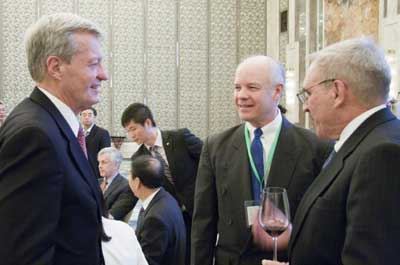
Following a USDA hosted dinner reception in Shenyang, China,
Greg Yielding, (center) rice market specialist for Emerging Markets
Programs for US Rice Producers Association and the Missouri Rice
Council, visits with Max Baucus, (left) U.S. Ambassador to China and
Scott Sindelar (right) Minister-Counselor for Agricultural Affairs, Beijing, China.
Photos by John LaRose
The Chinese don’t just eat medium grain, they eat long grain, medium grain and short grain. Mainly in the south about 90 percent is long grain, and in the north about 90 percent is medium grain.
The USRPA had suggestions for the Animal and Plant Health Inspection Service (APHIS), the agency that negotiates the protocols.
“We wrote the request for just long grain rice at first because APHIS felt with two different growing environments here – the medium grain Japonica rice that’s grown in California and the long and medium grain Indicia rice grown in the south – we should center on just one. We were going to do medium grain later in the northeast,” Yielding said.
The first effort was to see if there was a market for U.S. rice, and in the initial meetings, the Chinese were interested. But a study was needed to see if the consumer wanted to buy U.S. rice. That would help in convincing the Chinese government to purchase rice from the United States.
“Without the consumer interest, there wouldn’t be a reason to go forward with phytosanitary regulations,” he said. “China joined the WTO in 1999 and they set quotas and tariffs for imported rice from all countries, but with the United Stated they did not establish any phytosanitary protocols. There can’t be sales into China until that’s done.
“So we did surveys of U.S. rice in Metro stores, which are like Sam’s Clubs, and supermarkets in Guangzhou, Zhuhai, Shenzhen and Shanghai and two or three other cities,” Yielding said. “We prepared plain white rice in rice cookers and we offered a three ounce cup of rice to consumers. We also had rice in a bowl uncooked and they could look at it, touch it and smell it.
“As far as I know, the research we’ve been doing through our EMP grants from the USDA is the only research on consumer appeal that’s been done. So the Chinese are relying on our research. We’ve been in the larger cities and they want continued consumer research in the second tier cities, so that’s what we’re doing now. The USRPA is applying for a grant to do proposals in the second tier cities with just 5 or 6 million residents.”
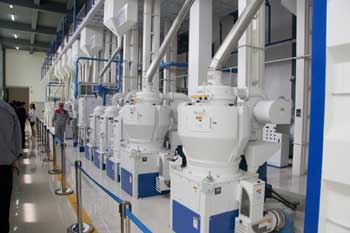
The interior of a rice mill in northeast China outside of
Changchun. Yielding commented “It was one of the nicest
mills I’ve ever seen.”
On each of his trips to China he visited different parts of the country introducing different types of rice to the Chinese public. On this recent trade mission he visited northeast China, a predominantly medium grain area.
“I have samples of Indicia and Japonica medium grain I’m taking there,” he said. “Before this, I was on a Missouri Department of Agriculture trade mission and we went to central China and western China. Each time I came we tried to further the protocols, and we’re now in the last stages of negotiating the protocols with the Chinese so we can send rice to China.
“Rice is the number one grain in China, obviously they’re the number one rice producers and the number one consumers in the world. They want to buy U.S. rice. It ran like in the 83 to 90 percentile of people who said ‘we want to buy it.’”
Also surveyed were the packaging types and size of packages and several different other questions. Data was compiled from the surveys, market data that showed the Chinese consumers wanted it. This was shared with the Chinese supermarkets and importers.
“That’s important because these people know people in government and they deal with government. One of the stores is a government supermarket chain and they see they can make money on this, the demand is there, so that’s going to help us get access. That’s why the surveys were important,” Yielding said.
One of the reasons it’s taken so long is the Chinese wanted to conduct a pest risk assessment; to come to the United States, visit fields and mills, production facilities, and check out everything, then write a report. They named certain quarantine pests they don’t want in China, and urged the United States to perform fumigation and other practices they want done before rice gets shipped to them. That all occurred in 2010, and they did a report, and APHIS began negotiating with them on protocols. China sent a draft protocol, and APHIS went from there, going back and forth. Approval is now in the final stages.”
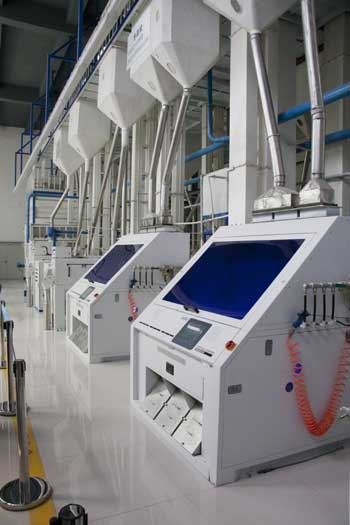
At the rice mill in Changchun they were using Satake equipment,
it was very clean, very sanitary, and the rice quality coming out was
very good. They do approximately 200,000 metric tons a year.
There is a protocol for shipping their rice into the United States, but the U.S. didn’t require a pest risk assessment, “We just said here is what you have to do. It can’t have any bugs in it, and here is how it needs to be shipped. We can inspect it at the port if we want too. They ship rice to the United States right now, and nine years later we’re still waiting for approval of our rice.”
Millions of dollars worth of rice has been imported into the United States from China. It’s just cheap Chinese rice, not specialty. Their market probably is everywhere, California, New York and the big cities.
Yielding visited one Chinese rice mill on the recent trade mission and found the facility was very nice, very modern.
“They were using Satake equipment, and it was very clean, very sanitary, the rice quality coming out was very good and I think they said they were doing 200,000 metric tons a year from that mill. It was one of the nicest mills I’ve ever seen,” he said.
“The main point is they have access to our market and we would like to get access to theirs, but we asked to do that without a pest risk assessment and they said no. So they came over and we showed them the different mills, the farms and farming practices so they could do a report to prepare phytosanitary regulations.”
There’s plenty demand in China for high quality rice to be sold at a premium.
“I think it will definitely increase rice production here once approved, more acres will be slated for rice, and farmers will get a better price for our rice,” Yielding said. “This is the biggest market in the world. We’re not talking about shipping bulk cargos over to China. Some of that could be done with broken rice, and I’ve had people wanting to buy brokens, or rice bran. The market is huge, there’s millions and millions of people living there, and there’s economic growth.
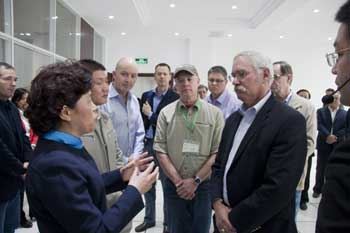
Greg Yielding (center) and Under Secretary Scuse (right) visiting
with representatives of a rice mill in Changchun. People in the
background are other members of the Agriculture Trade Mission.
“What they want is higher quality milled rice, either long grain or medium grain, not paddy rice,” Yielding explained. “It will be milled U.S. No. 1 identity preserved rice, branded, and shipped there in retail packaging so it retains its identity as American rice. We’re not talking about a market where we’re going to ship a bunch of rice and they’re going to package it. That’s what we don’t want to happen because somebody invariably is going to stretch it by putting Chinese rice or some other cheaper rice with it, and that’s going to be a marketing problem, a disaster. That kind of thing has already happened in China with the Thai’s where they have been actually caught putting Chinese rice into their high quality Jasmine rice. The Chinese caught them and it hurt their sales.”
U.S. producers, millers and exporters are ready to ship now, just waiting for the protocol to be approved.
“However, it’s going to be up to the individual people, it’s going to be individual mills and marketers who actually make the deals. What I’m trying to do is open the market, make contacts, and bring people together who are interested. We just need to keep pushing to get this done, then I can put people in contact with each other, but it will be up to the individual businesses to make whatever deal they want with them.”
Purchases could be made in several ways.
“If the government decided to buy, they could buy that way, but most likely purchases will be from private chains. Even private chains, such as the China Vanguard Group of 3,000 supermarkets in China, are partly owned by the government. They would just be the importer and they would import it, then the stores could buy from them, but also the stores could actually go through another private importer and they could bring it in. I’ve met with some of them and they are ready to do that.”
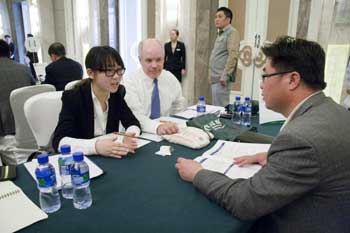
Greg Yielding (center) and interpreter (left) visiting with a large rice buyer.
“They all want to bring in American branded rice for the supermarket shelf.”
Yielding and USRPA have applied for another EMP grant from FAS to visit supermarkets in second tier cities. That is very important because neither the US Rice Producers Association or any association could do these programs on their own. Also, the expertise of the USDA agricultural trade offices that are in the countries are needed, and they’re very good to work with.
“The US Rice Producers just wants to open the markets, we don’t care if it’s rough rice or milled rice but this is a milled rice market. The greater the market, the better the prices, not just for farmers, but the chemical people, the air pilots who fly rice, the whole agricultural community of the United States. U.S. agricultural exports to China are the number one exports, soybeans are the largest crop exported. Agriculture is really important to U.S. exports, and especially, with the trade deficits as they are, if it weren’t for agriculture we would be in a sad situation,” Yielding said.
Rice acreages in the states could be over 3 million acres once shipments to China are approved, obviously with increases everywhere. There could be great increases in Missouri, with over 1 million acres grown there with an adequate water supply. Arkansas has approached 2 million acres before, it just depends on the different economics of soybeans and corn.
“There is a lot that goes into rice, air pilots fly a lot on rice, they may fly once, if at all, on soybeans,” he added. “The chemical companies, the seed companies, it will be good for all to have the markets. And the farmers would always prefer to have good markets and prices rather than any kind of government assistance.”
China needs imports. Already, they’re importing bulk rice out of Vietnam, Cambodia, and Thailand. China was the number one importer of rice last year, and farmers are moving to the cities.
“They’re going to work in factories right now,” Yielding said. “In some areas they told us some of the rice ground went to soybeans because of prices, just like here in the United States. If the price is different, the farmers are going to change if they know they can grow it.”
“The potential is unlimited as far as we are concerned,” Yielding said. “We only grow 1 percent of the rice in the world, but we export half of what we grow. We can definitely increase a lot of acres of rice by this market. They could eat everything we could produce in a year, presently in 11 or 12 days.”
The United States can’t even put a dent in their needs.
“No. But what we’re talking about in this market is not supplying just every kernal for whatever reason as far as their use, we’re just talking about high quality table rice, U.S. Number 1 grade, long, medium or short grain. The vice president of sales in China Vanguard told me in a meeting “We can sell as much U.S. rice as you can send us, and it doesn’t matter what the price is.’
Millers in the United States are encouraged by the possibility of shipping to China.
“There are several millers ready to sell rice into China, and they’re getting their trademarks registered in China. That’s something that anyone who wants to sell to China needs to do. Several mills have done this and they’re ready to go if we can just get the market. There are people ready to sell U.S. rice to China and there’s Chinese importers ready to buy it.” ∆
Editor’s Note: MAFG has scheduled for the July 25th issue an interview with US Rice Producers Association Bob Papanos. Bob is sharing his take on the potential of rice imports to China. Look for this informative interview.
In Next Week’s issue MAFG will report on China’s ban on US pork products put in place during April of this year, due to the Porcine epidemic diarrhea virus, or the PED virus, which appeared in the U.S. for the first time in April and has killed thousands of piglets since then.
The three previously published articles on US China Trade can be viewed at www.mafg.net.
JOHN M. LAROSE: Publisher, MidAmerica Farmer Grower
BETTY VALLE GEGG-NAEGER: Senior Staff Writer, MidAmerica Farmer Grower
|
|